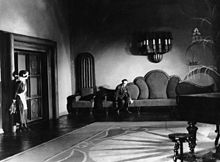Mise en Scène (film)
The expression mise en scène [ mizãˈsɛn ] ( French for setting the scene ), sometimes also called interior montage , describes the calculated structure of an image in film analysis , in the broader sense also the film direction itself. The spatial arrangement of the figures and things in the picture is essential - in contrast to the temporal arrangement of the pictures through the montage .
Basic principle

The basic principle of the Mise en Scène is a particularly careful visual composition according to play-dramaturgical criteria , for this purpose the scene is almost "modeled on a painting" (see picture). It is staggered in terms of spatial depth , i.e. subdivided into foreground, middle and background, and designed in a narrative strategy as well as generating meaning. An example of this is the film Citizen Kane (1941) by Orson Welles . A rear projection shows the deadly medicine and the suicide and in the background the door through which the husband comes into the room. In general, the mise en scène includes the entire picture arrangement, including the color composition, lighting , equipment , costumes , make-up and the management of the actors .
Reality claim
The term “mise en scène” was coined in the 1940s and 1950s by André Bazin , who thereby turned against the Hollywood design principle of montage. For him, the focus was on creating an illusion of reality that he viewed as cinematic realism. In contrast to the formalists of the Russian revolutionary film, who viewed film editing as the centerpiece of realistic filmmaking, he located films' demands for reality in the image structure. He pleaded for long, structured shots and a shift of the dramatic conflict into the composition of the film image - for example through a flowing movement of the camera (see also plan sequence ) and a coordinated, fluid staging of the action. In traditional montage, on the other hand , a scene would be "dissolved" in chains of settings that would have to be reassembled into a "reality" in the reception.
According to its allocation of Mise en Scène to realism pointed Bazin mounting the expressionism (not to be confused with the film era of expressionism ) because it produced correlations between the individual images that as a personal expression (in French. "Expression") of the filmmaker to evaluate. Jean-Luc Godard , on the other hand, saw montage as a subset of the mise en scène : “Montage only does in time what the mise en scène does in space. Both are principles of organization. ”According to Godard, creating a scene means“ organizing both time and space ”. In this context, this can be understood in such a way that both techniques can be suitable for the representation of certain aspects of reality as well as for the representation of expressionist aspects: Mise en Scène within space and montage within time. Accordingly, the Nouvelle Vague in particular was known for combining realism and expressionism both in the individual image and in the montage.
The New German Film , especially Alexander Kluge , continued this idea. However, Kluge questioned the reality of the simple image in his book Casual Work of a Slave . He stated that at least three aspects of the representation of reality stood in the way of this in the Mise en Scène :
- The fundamental difference between directly experiencing a situation and looking at its cinematic image.
- The selection of the camera setting, which not only shows something, but inevitably does not show anything else.
- The narrative patterns established in the medium, according to which the viewer inevitably interprets the image in a one-sided and calculable way.
Kluge speaks of the “objective situation” of the material: “You can't just say that the documentary depicts facts.” Accordingly, he called for the individual settings to be assembled in “forms of authentic observation” in order to depict reality. In doing so, Kluge contradicted Bazin’s system by emphasizing the mise en scène as a means of expression and at the same time showing the realistic possibilities of montage.
See also
literature
- David Bordwell, Kristin Thompson: Film Art: An Introduction . McGraw-Hill, New York 1990.
- Jürgen Kühnel: Introduction to film analysis . Part 2: Dramaturgy of the feature film. 2nd Edition. Universitätsverlag Siegen, 2007, ISBN 3-936533-16-4 .
Web links
Individual evidence
- ↑ Mise en Scène is the spelling according to Duden ; Capitalization of both words according to § 55 (3); In the literature there are other spellings such as mise en scène , which is based on French, mise -en-scène used in English , or also Mise-en-Scène or Mise-en-scène in German .
- ↑ a b c Hans Jürgen Wulff: Inner assembly. In: Lexicon of film terms. Hans J. Wulff and Theo Bender, accessed October 10, 2013 .
- ^ Werner Faulstich : Basic course in film analysis . UTB, Munich 2002, ISBN 3-8252-2341-8 , pp. 143 .
- ^ A b c Hans Jürgen Wulff: Mise-en-scène. In: Lexicon of film terms. Hans J. Wulff and Theo Bender, accessed October 10, 2013 .
- ↑ mediamanual.at: The language of film. Federal Ministry for Education, Art and Culture (BMUKK), 2008, accessed on October 10, 2013 .
- ^ Jean-Luc Godard: Montage, Mon Beau Souci. (PDF; 31 kB) (No longer available online.) In: Les Cahiers du Cinema. December 1956, archived from the original on October 15, 2013 ; accessed on October 15, 2013 . Info: The archive link was inserted automatically and has not yet been checked. Please check the original and archive link according to the instructions and then remove this notice.
- ↑ James Monaco : Understanding Film . Rowohlt, 2002, ISBN 3-499-61433-2 , pp. 177 .
- ↑ Alexander Kluge: Casual work of a slave . 3. Edition. Suhrkamp, 1975, ISBN 3-518-10733-X , p. 202 .
